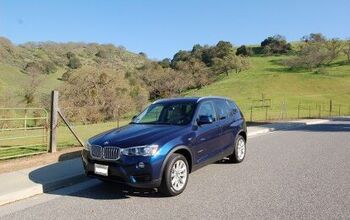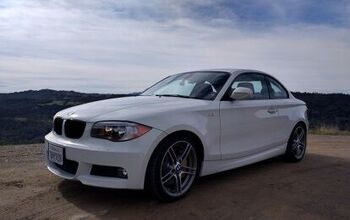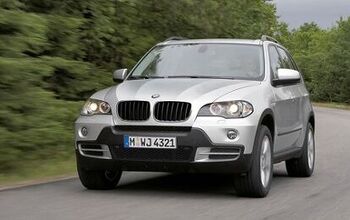Reader Review: BMW 120d
Reader Antoun sends us this review of a BMW 120d rental car from his most recent trip to Europe.
The BMW 120d is right at the bullseye of unrequited desire for – well, you, assuming you’re a compulsive reader of car blogs, where the irrationality of the wagon-on-stilts crossover craze and needlessly-complicated hybrid technology are well-worn topics. On paper, the 120d is the best of both worlds. To the performance junkie, it could be a sports car: rear-wheel drive, a touch over 3100 lbs of curb weight, and a turbo motor that kicks out 184 horsepower (measured in the Euro way, optimistic by US standards) and – get this – 280 ft/lbs of torque. Best of all, it can still be ordered with a 6-speed manual transmission and a real clutch pedal.
The 120d is also a practical five-door daily driver, with a reasonably sized and reasonably square cargo area accessible through a usefully yawning hatchback. At 170.2 inches long, it’s 4 inches shorter than an E36 3-series and a whole foot shorter than the current 3-Series.
So, is it the epiphany that internet forum-dwellers expect from the spec sheet? I spent ten days using a rental 120d for a variety of tasks, including carrying friends, family, and lots of luggage back and forth from train station to hotel. Several of our guests were of the occasional-traveler variety, with all of the ill-advised and oversize luggage choices that implies. We never ran out of room. A US-spec 1-series coupe would have had us running for a roof rack and ratchet straps.
I also spent time schlepping up the A1 highway between Rome and Florence with a fair number of detours to Tuscan towns on Italian country roads.
The local Italian drivers seem to always have their personal mannetinos set to “corsa” – Italian driving has less in common with an American commute than with the chaotic 3rd hour of a 24 Hours of Lemons race. In that context, the 120d’s chassis was a welcome dance partner, nice enough to make enthusiasts of 1990s BMWs quit kvetching. On both highways and bumpier secondary roads, the ride had the suppleness you would expect of a much larger car. Importantly, this car came with Bridgestone Turanza 300ER tires, which in this application are not of the run-flat variety. This takes a lot of the high-frequency jitteriness out of the ride when compared to the US-spec 3-series. It rolls much less than you’d expect given the compliant ride, and never seemed to run out of suspension travel. The car will hold a line through corners without getting unsettled by bumps, camber changes, or changes of elevation. It’s adjustable, albeit within narrow limits: the rear end will wiggle a bit if you are aggressive with the gas pedal in 1st or 2nd gear, but it never seems to step out at a massive angle despite all that torque. Overly-aggressive entry speeds will bring understeer, but the front tires never wash out to the “uh-oh” point, even with the stability control turned fully off.
What the 120d lacks is ultimate grip. Those Bridgestones are only 205/55-16s and designed for low rolling resistance – so if you’re looking for a mini-M3 this isn’t quite it. But the predictability of the chassis setup makes it a great tool for covering unfamiliar ground quickly, and the process is definitely fun.
The brakes – very important in Roman traffic! – are also fantastic. They have lots of feel, are easy to modulate, and able to brake beyond the limits of tire grip. On mountain roads of the variety that car commercials sell you, we never felt fade, even when loaded up with 2 people and lots of luggage.
One downside is the steering. The steering has moved to an electromechanical system with this generation of 1-series, but – surprise! – feedback is not really the issue. Yes, it lacks the kick and fizz of an E90’s wheel, but it gives more feedback than the current 3-Series and a lot more than an Audi A3 or A4. The real issue here is that the steering is weirdly non-linear: dead right on center, then responsive, then slower toward the end of the lock. The net effect is that it’s hard to steer smoothly, particularly into longer faster bends. When driving an unfamiliar car in the cut-and-thrust of Roman ring road traffic, hilarity and head-tossing ensue.
The interior was very familiar to those who have ridden in a modern BMW. Finely-grained plastics and rubber-coated knobs and buttons are all nice to touch. The cloth seats were ridiculously good, as comfortable as the more-bolstered Sport seats that BMW fits. For me, the seats fitted to non-Sport-package US BMWs usually don’t have a long enough bottom cushion to be supportive, but these seats had no such problems. 3- and 4-hour stints behind the wheel were pain-free.
So the car has a lot of the known BMW virtues, with a bit more old-skool BMW-ness than you might expect. What about that forbidden-fruit motor, so tempting to car guys trapped in the Garden of CUVs? It’s a turbo 4 with all the modern electronics that BMW can put an InterCapped marketing moniker on (TwinPower, EfficientDynamics, etc). Whoever tuned the exhaust deserves a promotion: from inside the car you hear a silky and deep-throated thrum that sounds nothing like the Cummins in a half-ton truck. Fans of Volvo red-block motors and 5-cylinder Audis will find this engine sounds familiar. More importantly, it felt at least as smooth, and maybe smoother, than the Audi TDIs that are this car’s natural showroom rival. With the windows rolled down you hear somewhat more rackety diesel noises, but in a world where direct-injection gas motors are fairly clickety-clackety, this engine sounds good.
The upside to this motor is the massive torque, and the price you pay for it is the narrow powerband. It has some turbo lag below about 1400 RPM, and runs out of breath noticeably at 4500 before redlining at 5500. In between – which, let’s face it, is where most real-world driving happens – the car feels revvy and eager. It’s got enough torque to lug around in 3rd gear all day long without feeling flat-footed. BMW says it goes from 0-60 in 7.2 seconds, and I don’t doubt it, but in the midrange it feels more like a low-6-second car. The disappointment here is that right at the point on the tach where you expect a BMW to take a deep breath and start charging harder, in the 120d it’s time to upshift.
And since you’re using that gearshift often enough to star in your own personal remake of BJ and the Bear, you will quickly come to find that it’s engineered for low NVH rather than a positive feel. The side-to-side action is well-sprung and pleasantly mechanical, but sliding the lever forward or back into gear is uncomfortably rubbery. There’s at least a half-inch of additional squishy action after the lever is actually in a gear. It takes some of the tactile joy out of driving the car fast on twisty roads. But the clutch takeup is perfect and the shift action is nothing a short-shift kit couldn’t fix. I’d still choose the manual over an automatic.
Our rental was the Unique trim level. A little irony, that: there’s nothing unique about yet another silver BMW with a black interior. Apparently this trim level gives you additional electronic and power toys (USB and phone jack input, Bluetooth, power seats) without going all the way to the expensive navigation system. iDrive is there, now with slightly flashier graphics and less infuriating user interface. If you like your cars to have a blinky screen on the dash, then you’ll probably think this one is okay, but not quite as great as a full-lux Audi MMI. If you’re old enough that your perception of “luxury” has nothing to do with accessibility to your Twitter feed, then this car’s interface will be perfectly adequate.
After nearly 1000 miles, I came to think that this car would be a perfect daily driver, in a way that our US-market 1-series, with its less practical coupe-only body style, wouldn’t be for most people. Prices are notoriously difficult to compare across continents, but in the UK it’s about 15% cheaper than an X1 crossover with the same engine. It gives up 2 inches of rear legroom and 10% of its cargo space compared to the X1, a difference that solo commuters and families with baby-seat-age kids might never notice.
I also came away thinking that the car would be even more of a driver’s car with more power at the top end of the rev range, like you might get from oh, say, a gasoline-fed inline-6. It’s not surprising that the M135i version of this hatchback, powered by the same 300-horse turbocharged motor found in our US-market 235s and 335s, has been a darling of the European press.
Here’s the kicker, though: We used only one and three-eighths of a tank of gas, over the course of a 1000 mile trip. We averaged over 55 MPG according to the trip computer, slightly above the car’s UK urban rating of 53MPG and well below its “extra-urban” rating of 69MPG. The M135i is rated at 27.4 urban / 35.3 extra-urban on the same UK rating scale. Would you give up 2000 RPM of powerband to get a 120d’s fuel economy? In hybrid-obsessed America, there is clearly a demographic that would. Are there enough of them to justify BMW’s cost to certify the motor in the U.S.? There is some astute spreadsheet jockey deep in the bowels of BMW’s product planning group who, I’m sure, knows the answer. The question, as always, is whether BMW’s U.S. product lineup reflects this spreadsheet jockey’s gimlet-eyed analysis of demand, or whether there is a truth that has not yet filtered up to the boardroom.
N.B. we are using a rights-free image due to a lack of original photography, hence the discrepancy between the article and the photo.
More by Ur-Turn
Latest Car Reviews
Read moreLatest Product Reviews
Read moreRecent Comments
- 3-On-The-Tree I have a 2009 C6 Corvette LS3 and the only major repair that I have done on it was replace the radiator. Besides usual plugs, wires oil etc. And yes those tires are expensive as well.
- 28-Cars-Later We had a red 2003 with less than 100 miles in late 2004/5ish and kept it till the end AFAIK. I do recall being told we had about $28,000 in at the time (about $43,6 in 2023 Clown World Bux). I don't ever recall anyone retail even looking at it, and it lived in the showroom/garage."It's an automatic that just had the linkage repaired and upgraded"This really doesn't bode well. Maybe there's a upgrade I'm simply not aware of so one could tune the 3rd Gen LM4 for higher power but messing with it isn't making me smile because now I know its no longer factory or somehow it broke and with such low miles I'm equally concerned.
- Analoggrotto With Kia Hyundai you are guaranteed to have the best Maintenance and Service experience in the industry. Complementary diagnostics, open book fees schedules and adherence to published rates with no attempts to tack extra work on are part of the HMC Gold Standard of Service. Recalls are the lowest in the industry but when you bring your Hyundai Genesis Kia vehicle in for Feature Improvement, rest assured that it will be taken care of to the highest pentagon standards, fully free of charge with no pressure for paid work or service unless requested. Hyundai Kia have the highest levels of customer ATP loyalty in the industry and Service is key to the best after sales experience.
- MaintenanceCosts In Toyota's hands, these hybrid powertrains with a single motor and a conventional automatic transmission have not been achieving the same kind of fuel economy benefits as the planetary-gear setups in the smaller cars. It's too bad. Many years ago GM did a group of full-size pickups and SUVs with a 6.0L V8 and a two-motor planetary gear system, and those got the fuel economy boost you'd expect while maintaining big-time towing capacity. Toyota should have done the same with its turbo four and six in the new trucks.
- JMII My C7 isn't too bad maintain wise but it requires 10 quarts of expensive 0W-40 once a year (per GM) and tires are pricey due size and grip requirements. I average about $600 a year in maintenance but a majority of that is due to track usage. Brake fluid, brake pads and tires add up quickly. Wiper blades, coolant flush, transmission fluid, rear diff fluid and a new battery were the other costs. I bought the car in 2018 with 18k in mileage and now it has 42k. Many of the items mentioned are needed between 20k and 40k per GM's service schedule so my ownership period just happens to align with various intervals.I really need to go thru my service spreadsheet and put track related items on a separate tab to get a better picture of what "normal" cost would be. Its likely 75% of my spend is track related.Repairs to date are only $350. I needed a new XM antenna (aftermarket), a cargo net clip, a backup lamp switch and new LED side markers (aftermarket). The LEDs were the most expensive at $220.


































Comments
Join the conversation
I owned the US spec 128 coupe, but it was just too darn annoying with two doors and no hatchback. I would order the HB you reviewed tomorrow, if they would bring it over here. Make mine a stick, with the 2 liter turbo (not against diesels, just prefer them in my truck, not car).
Next review, even more Yiddish please, because each usage makes me grin.